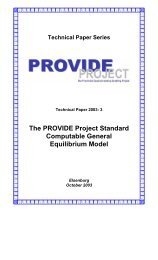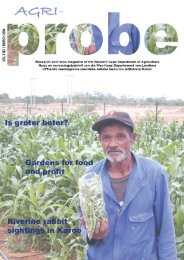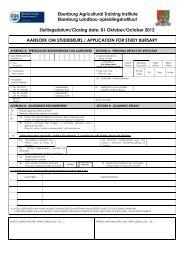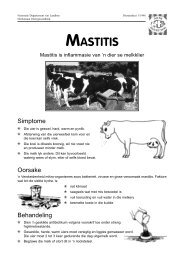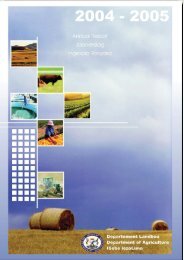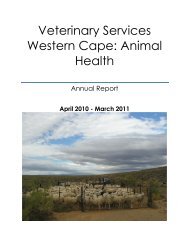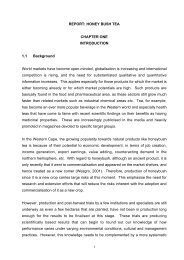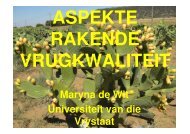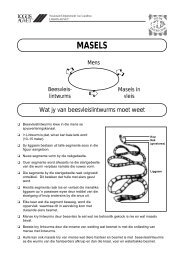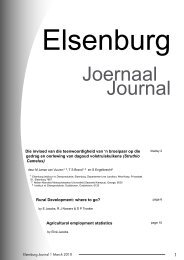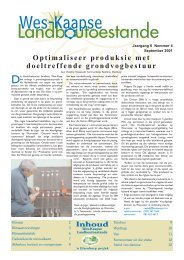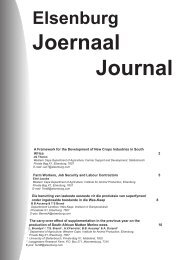Download AgriProbe - Department of Agriculture: Western Cape
Download AgriProbe - Department of Agriculture: Western Cape
Download AgriProbe - Department of Agriculture: Western Cape
You also want an ePaper? Increase the reach of your titles
YUMPU automatically turns print PDFs into web optimized ePapers that Google loves.
natural resource management, capacity building and partnerships. Through a process<br />
known as Area Wide Planning (AWP), the department works with groups <strong>of</strong> farmers<br />
to develop sustainable land management plans at a sub-regional level. These plans<br />
take into account the issues, needs and opportunities identified by the group and are<br />
linked to municipal Integrated Development Plans (IDPs). Through the AWP process,<br />
groups <strong>of</strong> farmers can identify projects and seek funding from LandCare and the local<br />
municipality.<br />
One <strong>of</strong> the functions <strong>of</strong> AWP is fine-scale farm planning. The <strong>Department</strong> <strong>of</strong> <strong>Agriculture</strong><br />
works with landowners to identify zones on their properties that are suitable for<br />
different land uses. In rural areas, the distinction is made between priority agricultural<br />
land and priority conservation land. Through the CAPE programme fine-scale (1:10<br />
000) biodiversity maps have been prepared for the Agulhas Plain indicating the vegetation<br />
types and areas that are most critically in need <strong>of</strong> conservation. The <strong>Department</strong><br />
<strong>of</strong> <strong>Agriculture</strong> uses these maps during AWP and farm planning exercises, and can<br />
therefore recommend not only which parts <strong>of</strong> the farm are most suitable for grazing,<br />
crops and infrastructure, but also which areas should be managed for biodiversity.<br />
Feedback from the biological surveys undertaken during the 1990s reaffirmed what<br />
many farmers in the area already knew: the Agulhas Plain was a biodiversity treasure.<br />
Rather than seeing this as a threat to their farming operations, some landowners<br />
recognised that conservation <strong>of</strong>fered them opportunities to diversify and improve their<br />
incomes. Once they knew which terrestrial and wetland habitats should be conserved,<br />
they could set these aside and continue farming on the less critical sections <strong>of</strong> their<br />
properties. The conservation areas then became an eco-tourism draw-card.<br />
By integrating agricultural and conservation planning in this way, the <strong>Department</strong> <strong>of</strong><br />
<strong>Agriculture</strong> is helping to implement the ecosystem approach to biodiversity conservation<br />
in a practical way on the Agulhas Plain.<br />
Dune asteraceous fynbos on the Agulhas Plain. Not the typical fynbos view.<br />
All photographs used with kind permission <strong>of</strong> Agulhas National Park, photograph by<br />
Douglas Euston-Brown.<br />
13<br />
Spot on!<br />
On the 5 km 2 site where Eskom<br />
planned to construct<br />
a nuclear power station<br />
45 plant species endemic<br />
to the Agulhas Plain were<br />
found, including four site<br />
endemics.<br />
AgriPROBE September 2007



